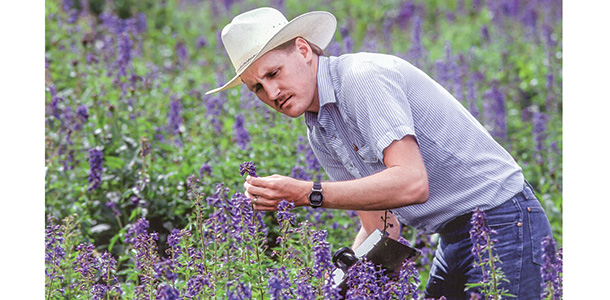These long-lived perennial plants are widely distributed and typically grow in spring under snowbanks and continue rapid spring growth when snowbanks recede.
Larkspurs are often divided into several classes depending on the plant height: tall, low and plains larkspur.
Tall larkspurs include four species: subalpine larkspur (D. barbeyi), duncecap larkspur (D. occiidentale), sierra larkspur (D. glaucum) and waxy larkspur (D. glaucescens), sometimes referred to as smooth larkspur.
Tall larkspurs typically contain numerous toxic alkaloids, which often cause substantial death losses when grazed by cattle.
Alkaloid concentrations are highest in the early growth and decline gradually in the plants during the growing season, with the exception of the seed pods, which accumulate relatively high concentrations of alkaloids in mature seeds.
Seasons and taste
Palatability to cattle usually increases after tall larkspur flowers. Consumption by cattle typically begins at flowering and increases as the larkspur plants mature, with cattle consumption peaking when larkspur is in the pod stage of growth in late summer.
Thus, cattle deaths are most likely to occur from the flower to early pod stages, when consumption normally increases and plant toxicity is still relatively high.
Cattle generally eat little or no larkspur before it flowers. Previous research with duncecap larkspur and subalpine indicated that most consumption by cattle occurred after flowering.
Thus, timing grazing in the late summer or early fall to coincide with larkspur maturity has been the most effective way for producers to manage animal mortality thus far.
Ranchers and University of Idaho Extension faculty in central Idaho had observed just the opposite occurring: cattle were consuming larkspur during spring when the larkspur plants were vegetative or in the bud stage of growth and before the larkspur plant had flowered.
This consumption of larkspur in the spring had proven fatal in many cases. These observations ran counter to previous research on the timing of larkspur consumption by cattle in areas dominated by subalpine and duncecap larkspurs.

All about location
Waxy larkspur in central Idaho and southwestern Montana occurs in somewhat different habitat compared to other tall larkspurs.
It is found primarily in mountain meadows and sagebrush areas above 6,000-foot elevation, but these waxy larkspur-populated areas tend to be drier than those areas populated by duncecap larkspur.
Duncecap larkspur typically grows in areas with deeper, moister soils, often with an abundance of other forbs and grasses.
Chemical analysis of waxy larkspur has indicated that this larkspur species is highly toxic; however, there is little information available about cattle grazing of this tall larkspur species.
Researchers from the USDA-ARS Poisonous Plant Research Lab (PPRL) in Logan, Utah, conducted a grazing study, in conjunction with University of Idaho Extension faculty and local ranchers, to try and answer the questions about when and how much tall larkspur (waxy) was being eaten by cattle during the spring in central Idaho near Challis.
A three-acre pasture was fenced with electric fence in an area with patches of waxy larkspur in the vegetative and bud stage of growth. The area was grazed with six Hereford steers that were naïve to larkspur.
All of the forage at the study site was actively growing during the study, and the spring forage was relatively abundant and had excellent nutritional characteristics.
Waxy larkspur was also an excellent source of nutrition but was also very toxic (toxic alkaloid concentrations measured above 2 percent; larkspurs containing more than 0.6 percent toxic alkaloids are considered to be highly toxic).
During the first few days on the study site, the steers ate very little larkspur. However, on day three, one steer ate sufficient larkspur and he showed visible signs of poisoning throughout the entire following day.
Similarly on days five and six, several steers ate sufficient larkspur that they were visibly poisoned on that day and the following day.
Progression of the clinical signs followed the classical pattern of minor muscle tremors progressing to major muscle tremors and then periodic collapse for 10 to 20 minutes.
Even though the larkspur was highly toxic, no animals were fatally poisoned – but two animals spent about 18 hours in lateral recumbency before recovering, indicating that they were very close to death.
Under these experimental circumstances, placing animals in the corral at night probably sufficiently interrupted and reduced their exposure to waxy larkspur such that no animals were fatally poisoned.
The larkspur was not uniformly distributed throughout the pasture, and cattle appeared not to seek it out or avoid it during their grazing activity.
Cattle consumption of waxy larkspur in this study was not due to a reduction in other available forage. Waxy larkspur is moderately palatable during spring, and cattle consumed the plant when other forages were available.
Results of this grazing study demonstrated that management recommendations for other tall larkspurs such as subalpine and duncecap larkspurs do not apply to waxy larkspur.
Unlike consumption patterns by cattle on these other two larkspur species, waxy larkspur is sufficiently palatable in spring to pose a serious threat to grazing cattle and the risk of death losses is particularly high because of the very high concentrations of alkaloids in young waxy larkspur plants.
Reducing losses
Ranchers with tall larkspurs need to be keenly aware of which larkspur species is growing in their pastures and grazing allotments and take precautions to limit cattle exposure to toxic larkspurs when cattle are most likely to consume the plants.
Information gained from this study will be vital when assisting ranchers in making grazing management decisions to reduce livestock losses to waxy larkspur in central Idaho.
There are various management strategies that may reduce cattle losses to tall larkspur but will require more intensive management for most livestock producers. They include the following:
-
Timing of grazing: Knowing what species of larkspur you have and the toxicity levels of that plant will help determine when to graze cattle in areas dominated with larkspur.
Toxicity decreases during late summer and fall after seed pod shatter; therefore, cattle can be moved to larkspur-dominated sites providing weeks of low-risk grazing while resting other areas of the range. -
Herbicidal control: Picloram at 2.2 pounds per acre kills tall larkspur when applied in the vegetative, bud and flower stages.
Control with herbicides is most economical when larkspur grows in dense patches that can be effectively treated. - Sheep grazing before cattle: Larkspur is much less toxic to sheep than cattle. Sheep may be used to graze or trample dense patches of tall larkspur, thus reducing availability or palatability to cattle.
-
Herding: On ranges where larkspur grows in patches, herding cattle into areas with less larkspur may reduce losses.
Herding can also move cattle to fresh feed and keep animals away from riparian areas. -
Mineral supplementation: Many ranchers feel that providing mineral supplements will reduce cattle consumption of tall larkspur or decrease its toxicity if they consume larkspur.
Numerous research studies have not supported this theory. It has been noted that higher levels of mineral intake has increased water intake; however, mineral supplementation did not greatly affect ruminal liquid passage rate, suggesting no beneficial effect such as rapid dilution of larkspur alkaloids in the rumen. - Drug intervention: Because larkspur kills animals by blocking acetylcholine receptors, drugs that increase acetylcholine concentrations at the receptor sites have great potential for reversing larkspur toxicity.
- Training cattle to avoid larkspur: Cattle can be trained to avoid tall larkspur, but this may be cost-prohibitive for most producers.
For additional information refer to this Utah University site to learn more about applying behavioral principles to influence diet selection of livestock. ![]()
References omitted due to space but are available upon request. Click here to email an editor.
PHOTOS
PHOTO 1: Ranchers in central Idaho discuss early season grazing of larkspur with research scientists from the USDA-ARS Poisonous Plant Research Laboratory. Photo courtesy of University of Idaho.
PHOTO 2: On high mountain rangelands in central Utah, range technician Gus Warr collects larkspur samples to measure alkaloid levels. Photo provided by USDA-ARS.








